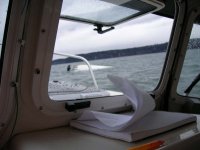Falco
New member
- Joined
- Dec 20, 2004
- Messages
- 164
- Reaction score
- 0
- C Dory Year
- 2004
- C Dory Model
- 22 Cruiser
Wow. I heard the first part of the CG SEA portion of this rescue on 16 while working on the Bucking Ho in its cozy boat house on Sat. It's amazing how far that signal reaches (about 20 miles inland from Puget Sound). Of course I couldn't hear you, Tom. This is a great opportunity for learning and to reconsider some basic fundamentals:
1. Wear a life jacket, period. Over 90% of boating fatalities are due to drowing and over half of these are due to cold water exposure. When your body become hypothermic, you can't swim, you can't even hang on to the side of a capsized boat. I just invested in the latest inflatables Mustang makes. It hurt to pay so much money, but I know I and my passengers will wear them. We don't have all the details yet from Tom, but clearly the male victim could have easily died. NOAA says the water temp on Sat in SEA was 47.3 F. Exhaustion occurs in 30-60 min. at this temp, with death at 1-2 hours.
2. Be prepared to conduct a rescue. Even in relatively populated waters like Puget Sound, you never know when you will "get the call". Monitor 16 (and know how to use your VHF), know the waters you are in, carry blankets, first aid kit, rope/throw bag, boat hook, etc.
3. Think through what you would do in a situation like this -- "virtual training". Hopefully we will get more info from Tom. Why back down on a person in the water vs. coming in bow first? What effect did the seas and winds have on Tom's actions? Take charge, be decisive. Note Tom's decision where and when to beach his boat following the rescue -- pretty level headed.
4. Learn and practice good seamanship. The water Tom describes is nasty. Though waves of 3-5 sound small by "offshore" standards, the periodicity of these waves in Puget Sound can be very small. This is not swell, this is a pounding. My bet is the Trophy hull could "handle" such seas, but the skipper and/or his/her equipment could not.
Hats off to you Tom (and your crew). There's a 48 pound King out there with your karmic name on it.
1. Wear a life jacket, period. Over 90% of boating fatalities are due to drowing and over half of these are due to cold water exposure. When your body become hypothermic, you can't swim, you can't even hang on to the side of a capsized boat. I just invested in the latest inflatables Mustang makes. It hurt to pay so much money, but I know I and my passengers will wear them. We don't have all the details yet from Tom, but clearly the male victim could have easily died. NOAA says the water temp on Sat in SEA was 47.3 F. Exhaustion occurs in 30-60 min. at this temp, with death at 1-2 hours.
2. Be prepared to conduct a rescue. Even in relatively populated waters like Puget Sound, you never know when you will "get the call". Monitor 16 (and know how to use your VHF), know the waters you are in, carry blankets, first aid kit, rope/throw bag, boat hook, etc.
3. Think through what you would do in a situation like this -- "virtual training". Hopefully we will get more info from Tom. Why back down on a person in the water vs. coming in bow first? What effect did the seas and winds have on Tom's actions? Take charge, be decisive. Note Tom's decision where and when to beach his boat following the rescue -- pretty level headed.
4. Learn and practice good seamanship. The water Tom describes is nasty. Though waves of 3-5 sound small by "offshore" standards, the periodicity of these waves in Puget Sound can be very small. This is not swell, this is a pounding. My bet is the Trophy hull could "handle" such seas, but the skipper and/or his/her equipment could not.
Hats off to you Tom (and your crew). There's a 48 pound King out there with your karmic name on it.

